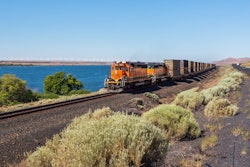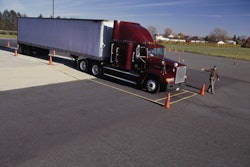Thanks to exhaust gas recirculation in 2007 engines, trucks are seeing hotter underhood temperatures than ever. Many fleets probably are wondering how to cope in the belts and hoses department.
“Even though we are seeing more temperature and pressure in the cooling system, we really haven’t pushed beyond the design limits of Gates hoses,” says Everett Bowen, the company’s industrial engine hose product manager. “We improved them in anticipation of 2007.” But with relatively few 2007 trucks sold, Bowen admits more troubles may become visible later. He also allows that there will be another such cycle getting ready for 2010, with some manufacturers expecting coolant temperatures to rise to 220-230 degrees Fahrenheit.
There are a few isolated problems, Bowen says, but based on evidence so far, the OEMs have gotten the bugs out of the common specifications. A few fleets that specify custom hoses and fittings have gotten into trouble: The truck ends up with an unusually long hose that may have a metal fitting in the middle, and it succumbs to vibration because it flexes and fails. “So put on a bracket to kill the vibration,” Bowen says.
Bowen says that in his 20-plus years in the industry, the biggest warranty issue always has been coolant leaks. The problem, he says, is three components – hose, clamp and fitting – all designed independently. This leads to failures and creates confusion when it comes to deciding who, if anyone, will pay a warranty claim. Bowen says hose makers need to ask questions, such as “Is the bead on your radiator fitting adequate to hold my hose?” The three parties need to get together, he says, and efforts are already under way to make that happen.
In the meantime, Bowen says, “Do a pre-delivery inspection the way you do a walk-through before buying a new house. Did the clamp get tightened properly initially?” The best fleets – Penske Leasing being a good example – do a good job with this and bill the factory for time spent fixing things, he says.
Another key is proper spec’ing. “Small fleets worry too much about initial cost,” Bowen says. “A better component can save in maintenance cost. What is the point of paying $50 for something rather than $100 if a year later it is going to cost you $200 to fix it?” He recommends looking over maintenance records, finding the problems – whether they exist in water pumps, coolant, radiators or alternators – and upgrading the problem components.
Don’t go offshore
One place Bowen is seeing trouble is hoses coming from offshore. “They look great, but may not have the burst or heat resistance,” he says. “Many such suppliers will sell you a hose at half the cost. There isn’t enough labor in a hose for such savings to come from cheaper assembly workers – most of the cost is in the materials, so they have to be buying something cheaper. These guys are cutting corners, and it will come back to bite you.” Bowen recommends that fleets demand test results from their supplier that prove the hose meets OEM requirements. “You get what you pay for. What happens to the engine when a hose bursts and the driver just keeps going until his overheat light comes on?”
Rod Ward, director of technology development at Flexfab, agrees. “When replacing a hose on the turbocharger’s high pressure side, go back to the OEM for the same hose design,” Ward says. “Some are even fluorocarbon-lined. You don’t want an off-the-shelf hose that doesn’t have the same Viton lining as the original.”
Steve Egleston, Flexfab’s technology development manager, recommends a similar approach with the crankcase ventilation systems used on 2007 engines. “You’d be smart to purchase OEM hose here, too, but for a different reason.” The turbo hose will leak air and soon cause the engine to be de-rated. But the crankcase ventilation hose can “leak oil through the sidewall,” ultimately making a mess of the engine compartment and eventually draining the pan.
When it comes to clamps, remember to buy quality – as when replacing those spring-loaded clamps. “Use the same type of clamp, and the same torque,” Egleston says. Refer to Recommended Practice 332, published by the Technology & Maintenance Council of the American Trucking Associations: RP 332 offers standards and instructions related to important factors such as the roundness and cleanliness of the stem.
The turbocharger is driving the design of hoses supplied by the OEM, Ward says. “You should replace with hoses designed to that standard,” he says. “Boost temperatures and pressures are higher than ever. Temperatures are over 450 degrees Fahrenheit, so we design our hoses for 500 degrees. There is no issue with underhood temperatures when you use the right silicone hoses.”
On the coolant side, recognize that different hose options are available. Some hoses may see up to 350 degrees F because of their proximity to EGR passages or a diesel particulate filter, which gets much hotter during active regeneration than normal. Another challenging situation for coolant hose is the jacket water EGR cooler at shutdown; cooling system pressure may rise to 18-19 PSI. Remember that premium options are designed for both higher temperatures and pressures, and specify accordingly.
Maintenance matters
In terms of routine maintenance, a careful initial inspection is recommended. Make sure hoses and clamps are in the proper position and torqued to the recommendation. Inspect hoses for discoloration or rubbing at regular maintenance intervals. Replace when discolored, and replace and/or, if appropriate, protect from rubbing as necessary. When replacing one that has failed, purchase a hose that meets the OEM specs for temperature and pressure.
Whenever removing the charge air cooler or radiator, inspect all hoses and stems carefully for damage during removal, and replace parts as necessary. “The latest cooling systems require more horsepower to drive the fan and put more load on the belts,” says Ken Bridges, Gates’ marketing manager for heavy-duty products. “There is also more heat under the hood, and heat is the number one enemy of rubber belts.”
Bridges also recommends careful monitoring of antifreeze strength: 50/50 coolant holds more heat at a given temperature, which helps minimize temperature rise – especially after shutdown – and will help preserve hoses. This needs to be done, Bridges says, because drivers often add straight antifreeze when coolant runs low.








